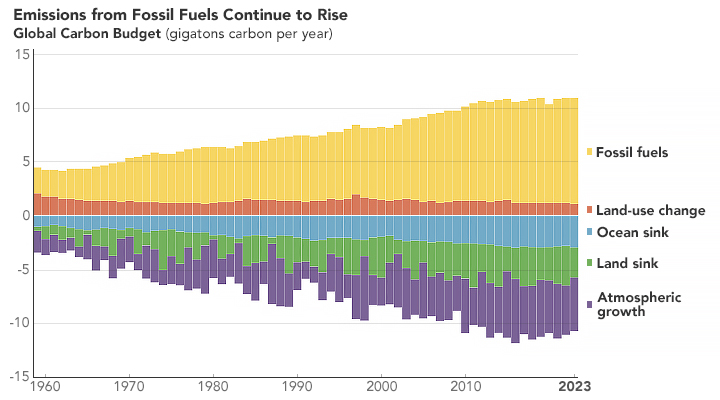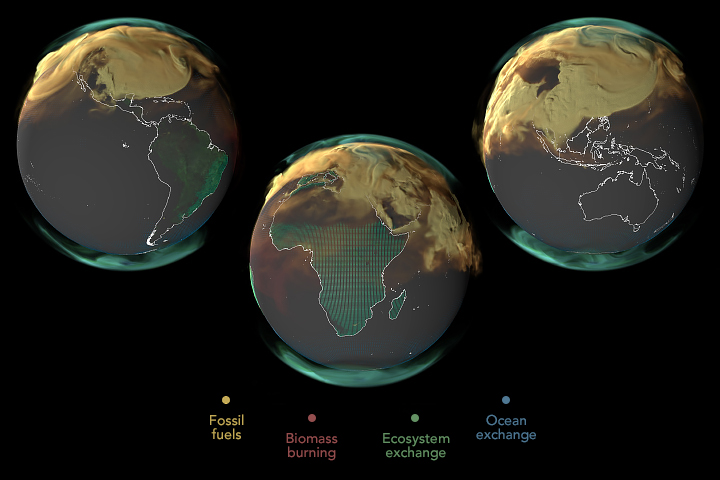
Emissions from Fossil Fuels Continue to Rise, Hindering Progress towards Sustainable Development Goals
Carbon dioxide emissions from fossil fuels rose again in 2023, reaching record levels, according to estimates from an international team of scientists. The continued rise in emissions from the burning of oil, coal, and natural gas is impeding progress to limit global warming, the scientists said.
The Global Carbon Budget
The finding is part of an annual checkup on Earth’s carbon cycle called the Global Carbon Budget. In this annual assessment, scientists quantify how much carbon was added to the atmosphere from burning fossil fuels and land-use change, and how much carbon was removed from the atmosphere and stored on land and in the ocean.
Record Increases in Carbon Dioxide Emissions
Scientists’ early analysis of 2023 data shows that emissions from fossil fuels rose 1.1 percent in 2023 compared to 2022 levels, bringing total fossil emissions in 2023 to 36.8 billion metric tons of carbon dioxide. When including other sources—such as deforestation and the extreme wildfire season in Canada—total emissions in 2023 were estimated to be 40.9 billion metric tons. Both 2023 and 2022 saw record increases in carbon dioxide from fossil fuels, according to the analysis.
“Emissions are heading the wrong direction that we need to limit global warming,” said Ben Poulter, a co-author of the report and scientist at NASA’s Goddard Space Flight Center. The concentration of carbon dioxide in the atmosphere has increased from approximately 278 parts per million in 1750, the beginning of the industrial era, to 420 parts per million in 2023.
Impact on Global Temperature
The rise in heat-trapping carbon dioxide—and other greenhouse gases—is the primary reason for the planet’s soaring temperatures. The global surface temperature in 2023 was 1.2 degrees Celsius (2.1 degrees Fahrenheit) warmer than the average for NASA’s baseline period (1951-1980), making it the hottest year on record.
Understanding Carbon Dioxide Flow
The visualizations above shows the flow of carbon dioxide into, around, and out of Earth’s atmosphere over the course of 2021 (the most recent full year of available data). They rely on NASA’s Goddard Earth Observing System (GEOS), a modeling and data assimilation system used for studying the Earth’s weather and climate. To depict where carbon is being emitted or taken up, researchers used data on vegetation, human population density, and the location of wildfires, power plants, roads, railways, and other infrastructure.
The carbon dioxide shown in the visualizations comes from four major sources: fossil fuels (yellow), burning biomass (red), land ecosystems (green), and the ocean (blue). Though the land and ocean are both carbon sinks—which means they store more carbon than they emit by removing carbon dioxide from the atmosphere—they can be sources at certain times and places. The green and blue dots represent carbon that was absorbed by the land and ocean.
“Amazingly, the ocean and land continue to absorb about half of the carbon we emit,” Poulter said. “Only about 44 percent of emissions stay in the atmosphere each year, slowing the rate of climate change, but causing ocean acidification and altering how land ecosystems function.”
Concerns about Ocean Carbon Sink
The proportion of carbon dioxide that stays in the atmosphere, known as the airborne fraction, has remained remarkably stable over the past 60 years, even with the continued increase in human-caused emissions. But scientists question whether and for how long that stability will continue.
A NOAA-led study published in 2023 analyzed carbon storage in the ocean over two decades and found evidence that this carbon sink may be losing some of its storage capacity. They speculate that the ocean has slowed its absorption because it has already accumulated substantial amounts of carbon dioxide. And changes in global ocean circulation may be decreasing the amount of carbon that is transferred from surface waters to the ocean floor, where it can be stored for hundreds of years.

Components of the Global Carbon Cycle
The chart above shows the combined components of the global carbon cycle from 1960 to 2023. It shows how much carbon is being emitted from fossil fuels (yellow) and land use change (orange), and
SDGs, Targets, and Indicators Analysis
1. Which SDGs are addressed or connected to the issues highlighted in the article?
- SDG 13: Climate Action
- SDG 14: Life Below Water
- SDG 15: Life on Land
The article discusses the rising carbon dioxide emissions from fossil fuels and their impact on global warming. This directly relates to SDG 13, which aims to take urgent action to combat climate change and its impacts. Additionally, the article mentions the absorption of carbon dioxide by the ocean and land, highlighting the importance of SDG 14 (Life Below Water) and SDG 15 (Life on Land) in preserving ecosystems and biodiversity.
2. What specific targets under those SDGs can be identified based on the article’s content?
- SDG 13.2: Integrate climate change measures into national policies, strategies, and planning.
- SDG 14.1: By 2025, prevent and significantly reduce marine pollution of all kinds.
- SDG 15.2: By 2020, promote the implementation of sustainable management of all types of forests.
The article emphasizes the need for integrating climate change measures into national policies and planning to address the rising carbon dioxide emissions. This aligns with SDG 13.2. Additionally, the mention of ocean acidification and the impact on marine ecosystems highlights the importance of preventing and reducing marine pollution, as stated in SDG 14.1. The article also mentions the absorption of carbon dioxide by land ecosystems, emphasizing the need for sustainable management of forests, which is a target under SDG 15.2.
3. Are there any indicators mentioned or implied in the article that can be used to measure progress towards the identified targets?
- Indicator 13.2.1: Number of countries that have integrated mitigation, adaptation, impact reduction, and early warning measures into national policies, strategies, and planning.
- Indicator 14.1.1: Index of coastal eutrophication and floating plastic debris density.
- Indicator 15.2.1: Progress towards sustainable forest management.
The article does not explicitly mention specific indicators, but based on the identified targets, the following indicators can be used to measure progress:
– Indicator 13.2.1 measures the integration of climate change measures into national policies and planning.
– Indicator 14.1.1 measures the level of marine pollution, including coastal eutrophication and floating plastic debris density.
– Indicator 15.2.1 measures progress towards sustainable forest management.
4. Table: SDGs, Targets, and Indicators
| SDGs | Targets | Indicators |
|---|---|---|
| SDG 13: Climate Action | 13.2: Integrate climate change measures into national policies, strategies, and planning. | 13.2.1: Number of countries that have integrated mitigation, adaptation, impact reduction, and early warning measures into national policies, strategies, and planning. |
| SDG 14: Life Below Water | 14.1: By 2025, prevent and significantly reduce marine pollution of all kinds. | 14.1.1: Index of coastal eutrophication and floating plastic debris density. |
| SDG 15: Life on Land | 15.2: By 2020, promote the implementation of sustainable management of all types of forests. | 15.2.1: Progress towards sustainable forest management. |
Behold! This splendid article springs forth from the wellspring of knowledge, shaped by a wondrous proprietary AI technology that delved into a vast ocean of data, illuminating the path towards the Sustainable Development Goals. Remember that all rights are reserved by SDG Investors LLC, empowering us to champion progress together.
Source: earthobservatory.nasa.gov

Join us, as fellow seekers of change, on a transformative journey at https://sdgtalks.ai/welcome, where you can become a member and actively contribute to shaping a brighter future.







